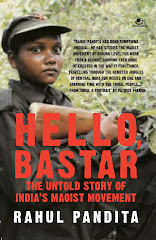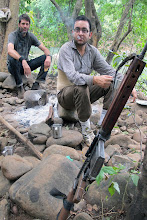 Every fire starts from the belly, says Ranjit Mahato. Sitting on a string cot, and occasionally caressing his bandaged leg, Mahato awaits police fury. There is just a large tree and one order between him and the police. A day before, the security personnel have liberated the Lalgarh police station. Now they wait for the order to move forward. Beyond this they dare not go. Two kilometres ahead, the road has been closed by a tree felled by the Maoists. The Maoist leaders had been camping in this area, monitoring the agitation. They have moved ahead. But Ranjit Mahato cannot go anywhere. Where does one go, leaving his home behind, he mumbles. But it is only to himself that he talks.
Every fire starts from the belly, says Ranjit Mahato. Sitting on a string cot, and occasionally caressing his bandaged leg, Mahato awaits police fury. There is just a large tree and one order between him and the police. A day before, the security personnel have liberated the Lalgarh police station. Now they wait for the order to move forward. Beyond this they dare not go. Two kilometres ahead, the road has been closed by a tree felled by the Maoists. The Maoist leaders had been camping in this area, monitoring the agitation. They have moved ahead. But Ranjit Mahato cannot go anywhere. Where does one go, leaving his home behind, he mumbles. But it is only to himself that he talks.A month ago, Mahato was seriously injured while escaping from the police who fired at a group of people in the Jhitka forest near his village. The people were planning their further course of action. Lalgarh was virtually cut off from the rest of West Bengal after angry villagers cut roads to protest police excesses against the tribals. On 2 November, 2008,Chief Minister Buddhadeb Bhattacharjee narrowly survived a landmine blast near Lalgarh. The whole agitation in Lalgarh erupted after the police action that followed. But Mahato says the fire had been simmering for quite a while – in their bellies.
For more than three decades Lalgarh had been a CPM bastion. In the neat and tidy tribal houses, the CPM flag shared space with their deities. “We were all CPM,” Mahato says.

But over the years, life had become tougher. In most of the villages there is no electricity. The local CPM leaders would distribute cards meant for people living below the poverty line only among a chosen few – their friends and relatives. In the ration shop the two rupee per kg. rice would be available all the time. But Mahato and many others like him would have no access to it. “We were forced to buy the same rice for seven rupees and it was scarcely available at the shop,” Mahato says. There were job cards of the rural employment guarantee scheme (NREGS). But there was no work. Many people went hungry.
And, then, villagers started noticing a few unknown men. They would just hang around, occasionally asking people if they needed anything. They would ferry sick villagers to the town, and after few days, follow up again, offering free medicine and even monetary help. They demanded nothing in return, except the odd request to help cook a bag of rice which they would bring with them.
In the 2008 panchayat elections, insecure CPM leaders began clamping down on villages in Lalgarh. They forcibly asked villagers to nominate CPM leaders. “One night the CPM workers came with police. They said: ‘CPM supporters stand towards the left and others to the right’. Those at the right were all taken away,” says Mahato. In the Lalgarh block, 70 people were arrested. Meanwhile, the unknown men would pay a visit to the weekly haat in the village, with a rifle now slung on their shoulders. One of them would speak about how the tribals were being exploited, and how the politicians were becoming richer. “The people would listen to them,” says Mahato. By the time the police swung into action, Lalgarh had turned into a Maoist stronghold.
As the police deserted their positions in Lalgarh, the Maoists took over. “They encouraged us to fight with whatever was in our possession,” says a villager.
As the security forces inched forward in Lalgarh, the Maoists retreated deeper, leaving behind villagers. The police along with the central security forces swooped upon village after village, beating up and torturing people, accusing them of being Maoist supporters.
The police have not been issued any specific guidelines except orders to ‘flush out’ the Maoists. Since the Maoists are hardly indulging in direct encounters, the police treats every villager as a suspected Maoist. And that suspicion shows in the way they are dealing with the situation.
The police came to Kuldiha village where they first beat up 45-year-old Vijay Mahato. They didn’t spare anyone – not even an 80-year-old woman, who was dragged by her hair by a policeman. They vandalised everything. Two motorcycles were damaged and then thrown into the village pond. A jackfruit tree was destroyed. “One of them ordered me to raise my hands, and the other started beating me up,” says Vijay. Before leaving, the policemen took away his radio and torch. Shortly afterwards, the entire village fled away, taking shelter in a nearby school. Vijay and his family stayed behind, because they had to tend to their cows. Many young men were picked up. Dozens of such villages are empty now.
Such is the beating Ranjit Mahato has been anticipating.
In Kamarpara village, an old man is the only one left behind. He curls up the moment he sees us entering the village. “I have done nothing,” he pleads. He is too scared after what he has witnessed. Though he does not reveal anything, other villagers who now are in the school, speak of the police brutality. In another nearby village, Janardhan Mahato watched helplessly as policemen beat up his son, and as his daughter-in-law fell at a policeman’s feet, she was kicked away. Even after she had lost consciousness, a police woman kept on slapping her senseless body.
All schools are closed. Some of them have been taken over by the police force. The one such as in Pirakata houses the refugees now.
From a village near Pirakata, Tarun began his walk at dawn. The night before, CPM workers came and beat up many villagers. They escaped in the dawn fearing yet another round of beating by the police. The shops have been closed for many days, and food had been hard to come by. “God only knows how we have survived all these days,” he said, on the way to Midnapore with his wife and three children. They carried a few utensils and a change of clothes. Their most prized possession was a packet of Britannia Tiger biscuits. Midnapore town is about 40 kilometres from their village. They would have to walk it down for many hours in extreme heat.
The heat is so extreme it could kill you in few hours, sapping all water from your body. Before the Lalgarh police station is taken over by the police force, journalists wait with their notebooks and mikes, waiting for the police force to move ahead. A hen flutters around cautiously, stopping, every now and then, on one leg. There is nothing to do except wait. As they do that, journalists pass on bottles of water and potato wafers among themselves. The security men have nothing except their weapons. Some of them have dirty water bottles which they carry with string attached to their belts.

A few stretches secured earlier by the police have been taken hold of by the angry villagers backed by the Maoists. A few armed Maoists have been spotted nearby. Some journalists and a police party rush towards that area. There is a confrontation. From a village nearby, tribals make traditional battle cries to scare the policemen. “Doesn’t it look like as if they are fighting the British?” a photographer says.
Five minutes after the media persons leave for Midnapore town, where they are putting up in two hotels which have doubled their rates ever since, there is a landmine blast. Two policemen are injured. Deep into the forest, the COBRA Special Forces are hunting for Maoists. But the senior cadre has already shifted.
From his hideout, the Maoist’s second-in-command, Comrade Kishenji is readying the Maoist bulletin. He is on phone continuously, giving interviews to news channels. The day police storm into the Lalgarh town, Kishenji has been interviewed by at least two dozen media organisations. That morning, newspapers have quoted the founder of the Naxalbari uprising, Kanu Sanyal saying that Lalgarh is not a communist movement. Kishenji thunders back, his mellow voice turning hard for a while. “Kanu Sanyal is a pheriwala, a hawker for the CPM,” he says. “If you have further questions, please call me in the morning,” he says. “I have two more interviews lined up.” It is already way past midnight.

The Colonypara village is just behind the Lalgarh police station, a small cluster of about 20 houses. There is no electricity, and the only source of water is a lone hand pump. Manju Sen has a NREGS job card, and she got work for three days, last year. But she didn’t receive a penny for it. A month ago, a local Trinamool leader came to her house and took the card away. “I have not seen it ever since,” she says. “At least they could have paid me for those three days.”
The heat has intensified. The temperature hovers around 40 degree Celsius but the relative humidity is about 90 percent. On both sides of the thin stretch of road leading to Lalgarh, there is a dense jungle of Sal trees. The Police and paramilitary jawans sit on both sides, taking positions against an enemy they cannot see. They have no clarity about the operation. “We are not doing anything except wait in this dense jungle, and that is killing us,” said a paramilitary jawan.

But it is not the wait or the Maoists which killed Nabakanta Roy, a jawan of the Central Reserve Police. It was the Union of India. In the absence of any basic facilities like water, he died of a heat stroke. A jawan, who had been walking for miles with a heavy bag of explosives, a bullet proof jacket and two rifles, and without access to drinking water, collapsed just before the Lalgarh police station. We offered him a lift in our vehicle, and some glucose water. About 50 soldiers have been admitted to the hospital with dehydration. Six of them had to be airlifted for urgent medical intervention.
Sitting with his back against a tree, a CRP jawan waits for food to arrive. A fellow soldier has gone searching for water. “There is no action, and this heat is killing me,” he says. There is a pause, and in the silence of the Jhitka jungle, I think I heard his stomach rumble.
He looks at me. His voice is unsoldierly. “I cannot fight when I am hungry.”
Some fires die in the belly.
(The report first appeared as cover story for OPEN magazine, July 3 issue)

















